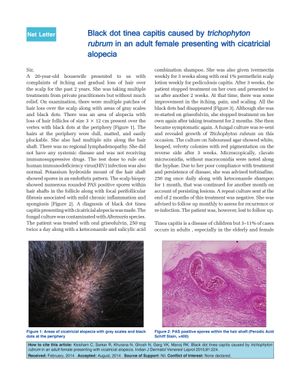Black Dot Tinea Capitis Caused by Trichophyton Rubrum in an Adult Female Presenting with Cicatricial Alopecia
January 2015
in “
Indian journal of dermatology, venereology, and leprology
”

TLDR A woman's scalp infection caused by a fungus led to permanent hair loss and was hard to treat but responded to a specific antifungal.
In 2015, a 20-year-old woman presented with a 2-year history of itchy scalp and progressive hair loss, which was diagnosed as black dot tinea capitis caused by Trichophyton rubrum, presenting with cicatricial alopecia—a form of permanent alopecia due to scarring. Despite multiple treatments, including oral griseofulvin and topical therapies, her compliance with the treatment regimen was poor, leading to recurring symptoms. A fungal culture confirmed the presence of Trichophyton rubrum. The patient showed some improvement with antifungal therapy, but the treatment was not completed as prescribed. The case was notable because tinea capitis is more common in children, with Trichophyton rubrum being a less common cause, and the association with cicatricial alopecia had not been reported before. The patient's condition was also resistant to griseofulvin but responded to terbinafine, aligning with studies suggesting Trichophyton species are more responsive to terbinafine. The patient was eventually lost to follow-up.

